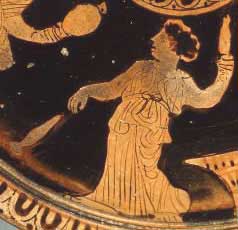
Hand spindles with whorls
Spinning has probably been around almost as long as people have. Every group of people known on earth at least knows how to pick some long grass or animal hair (or some of their own hair) and roll it back and forth along their leg or between their hands until the grasses all twist together and make a stronger piece of twine (twine after all just means something that is twisted). You can try this yourself with some long grass or some of your hair (don’t cut it! Your parents will kill me. Just break off a few strands). This kind of spinning makes a good string for setting a trap or tying a leather bag closed. You can even use it to make a grass skirt, with a belt of braided grass and some twisted fibers hanging down. Some people think that wearing a skirt like this meant that you were ready to have babies.
Tibetan woman spinning
But it isn’t very good for clothes that are actually going to cover you and keep you warm. For that people used fur and leather at first. But as there got to be more and more people around, say by around 5000 BC, it was hard to kill enough animals for everyone to have fur coats.

Ancient Greek woman using a drop spindle to spin
So people began to think of new ways to make cloth. Someone invented the spindle. A spindle is basically a thing that spins. It spins like a top: you give it a twist and let it go, and it spins for a while and then falls down. In fact it is a kind of top, and spinning is sort of a cross between using a top and using a yoyo.
In order to make a spindle, you take any fairly straight stick you find lying around (there’s no need to take the bark off even), about a foot long. And you take a gob of clay and make it round like a ball, and then flatten it a little bit, and you push the gob of clay over the end of the stick so the point of the stick shows out the other side a little. And you let the clay dry.

Aztec woman spinning with a supported spindle (Codex Mendoza, 1520s AD)
(If your stick is a little thicker near the bottom, it will help the clay stay on). The stick is called the spindle and the clay part is called the whorl.
Then you take some wool and you twist a little up on your leg or between your hands, and you tie that to the top of the spindle, and you give the spindle a twist and let it go, like a top, falling to the ground slowly, like a yoyo. Meanwhile with the other hand you feed out more wool from a bunch you are holding. The spindle twists it up for you as it falls. When it stops spinning, or reaches the ground, you flick it back up into your hand (like a yoyo), wind on the thread you’ve made, give it another twist and let it go again.
More about spinning
Learn by Doing – Spinning project
Bibliography and further reading about spinning:
You Can Weave!: Projects for Young Weavers, by Kathleen Monaghan (2001).
World Textiles: A Concise History, by Mary Schoeser (2003). For adults.
Women’s Work: The First 20,000 Years : Women, Cloth, and Society in Early Times, by Elizabeth Wayland Barber (1995). Not for kids, but an interested high schooler could read it. Fascinating ideas about the way people made cloth in ancient times, and why it was that way.




[…] was probably invented much later than spinning, around 6000 BC, in West […]